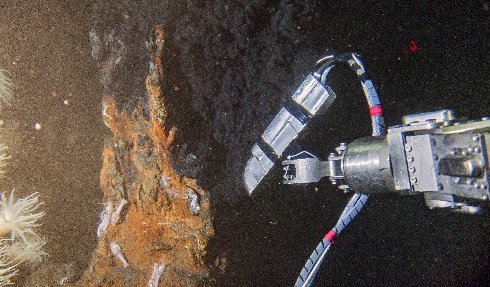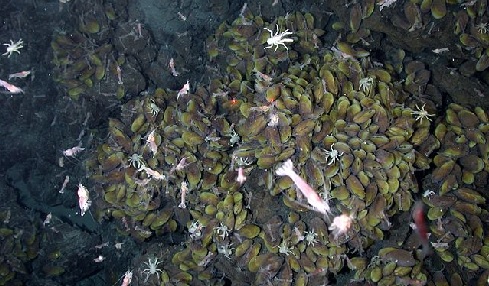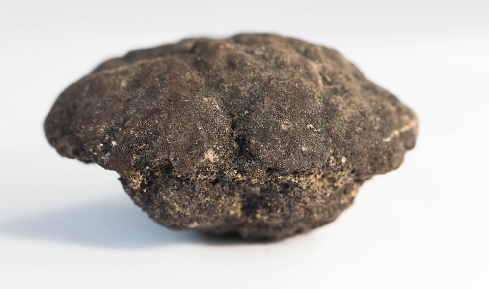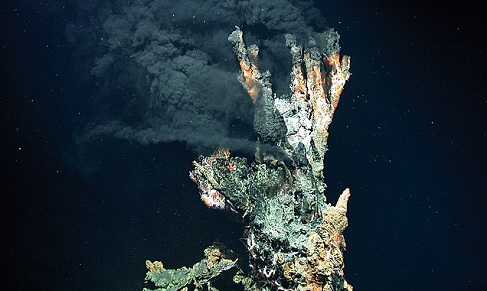Deep trouble

Above: the SHINKAI 6500 submersible at the Edmond hydrothermal vent field on the Central Indian Ridge. Chong CHEN / JAMSTEC.
Next year, the first commercial-scale mining operations in international waters are due to start, helping feed a growing demand for rare-earth metals. Elin Thomas explores what this means for the species that inhabit the extraordinary deep-sea habitats being targeted
May 27th 2022
For many the deep sea is a distant and dark place that is all too easily disregarded. To quote a famous cartoon published in The New Yorker in 1983: “I don’t know why I don’t care about the bottom of the ocean, but I don’t.” However, some habitats on the deep seafloor now face unprecedented threats that endanger the existence of some of their most charismatic species.
Of the various threats facing the deep sea, surely the most intensely debated is deep-sea mining. Dotted across parts of the deep seafloor are rich mineral deposits, with high concentrations of cobalt, copper, zinc, nickel, silver, gold and rare-earth metals. These metals are commercially valuable, used in batteries, phones and laptops, as well as renewable energy devices and electric vehicles. As societies shift away from fossil fuels towards these more sustainable devices and with terrestrial deposits of such minerals depleting, it has been suggested that mining these resources from the deep may be the only way of supplying such technology. But at what cost?
As well as being rich in metals, these areas are rich in life, supporting important benthic habitats and communities. Hydrothermal vents, for example, are among the most unique and productive habitats on Earth. Discovered only in 1977 on the Galápagos Rift, they host dense aggregations of highly specialised and largely endemic faunal communities sustained by the intense chemical energy of the vents. Picture tall chimney-like structures gushing out superheated jets of mineral-rich ‘black smoke’ and surrounded by extraordinary species, from giant red tubeworms (Riftia pachyptila) and iron-armoured snails (Chrysomallon squamiferum) – which both have specially adapted organs where they host chemosymbiotic bacteria – to hairy squat lobsters (Kiwa sp.) that farm bacteria, and heat-resistant Pompeii worms (Alvinella pompejana).
Around 600 active hydrothermal vent fields have been recorded worldwide, each with unique faunal communities, yet these small oases occupy an area less than the size of Manhattan. Due to the uniqueness of this habitat, the majority of hydrothermal vent species are incapable of colonising other seafloor ecosystems.
 Above: Deep-sea fauna on hydrothermal vents, including squat lobsters and vent mussels. Picture courtesy of the NOAA's Submarine Ring of Fire 2006 Exploration and Vents Program.
Above: Deep-sea fauna on hydrothermal vents, including squat lobsters and vent mussels. Picture courtesy of the NOAA's Submarine Ring of Fire 2006 Exploration and Vents Program. The deep-sea mining industry has three main targets: seafloor massive sulphide deposits, which form at hydrothermal vents along tectonically active mid-ocean ridges; polymetallic nodules scattered across areas of the abyssal plain; and cobalt-rich crusts, associated with the summits and flanks of seamounts.
The majority of these resources are located beyond national jurisdiction and as such are regulated by the International Seabed Authority (ISA), while the rest lie within the Exclusive Economic Zones (EEZs) of coastal countries where individual governments hold national jurisdiction. To date, the ISA has granted more than 30 exploratory mining contracts and deep-sea mineral exploration of some form has been undertaken within the EEZs of nine different countries, with full-scale commercial mining just around the corner.
The potential impacts of mining on these insular deep-sea environments have therefore been the focus of intense research over the last decade. Possible impacts include the dispersal of potentially toxic sediment plumes, both along the seafloor and within the water column, shifts in ecosystem structure and functioning, habitat removal and a net loss of biodiversity. Studies clearly demonstrate that mining will have an adverse, perhaps irreversible, impact on deep-sea faunal communities, but the demand for the precious resources in these habitats continues unabated. How many species may disappear from the bottom of the ocean without anyone even knowing about them? After all, contemporary estimates of marine species richness suggest that up to 91% of eukaryotic species in the ocean remain undiscovered.
 Above: A polymetallic nodule, the target of most deep-sea mining operations.
Above: A polymetallic nodule, the target of most deep-sea mining operations.  Above: the “Candelabra” black smoker at 3,300 meters in the Logatchev Hydrothermal Field on the Mid-Atlantic Ridge. Courtesy: MARUM – Centre for Marine Environmental Sciences, University of Bremen.
Above: the “Candelabra” black smoker at 3,300 meters in the Logatchev Hydrothermal Field on the Mid-Atlantic Ridge. Courtesy: MARUM – Centre for Marine Environmental Sciences, University of Bremen.Elin Thomas is a PhD student at Queen’s University Belfast, where she studies the conservation of deep-sea benthic invertebrates. She is also affiliated with the IUCN SSC Mollusc Specialist Group through her work on the vent Red List.
1) Jamieson, A.J. et al. Fear and loathing of the deep ocean: why don’t people care about the deep sea? ICES J. Mar. Sci. 78(3), 797–809 (2021).
2) Miller, K.A. et al. An overview of seabed mining including the current state of development, environmental impacts, and knowledge gaps. Front. Mar. Sci. 4, 418 (2018).
3) Hein, J.R. et al. Deep-ocean mineral deposits as a source of critical metals for high- and green-technology applications: Comparison with land-based resources. Ore Geol. Rev. 51, 1–14 (2013).
4) Van Dover, C.L. et al. Scientific rationale and international obligations for protection of active hydrothermal vent ecosystems from deep-sea mining. Mar. Policy 90, 20–28 (2018).
5) Rodrigues, A.S.L. et al. The value of the IUCN Red List for conservation. Trends Ecol. Evol. 21(2), 71–76 (2006).
6) Sigwart, J.D. et al. Red Listing can protect deep-sea biodiversity. Nat. Ecol. Evol. 3(8), 1134 (2019).
7) Thomas, E.A. et al. Assessing the extinction risk of insular, understudied marine species. Conserv. Biol. (36)2, 1–10 (2021).
8) Thomas, E.A. et al. A global Red List for hydrothermal vent molluscs. Front. Mar. Sci. 8, 713002 (2021).
9) Amon, D.J. et al. Assessment of scientific gaps related to the effective environmental management of deep-seabed mining. Mar. Policy 138, 105006 (2022).


